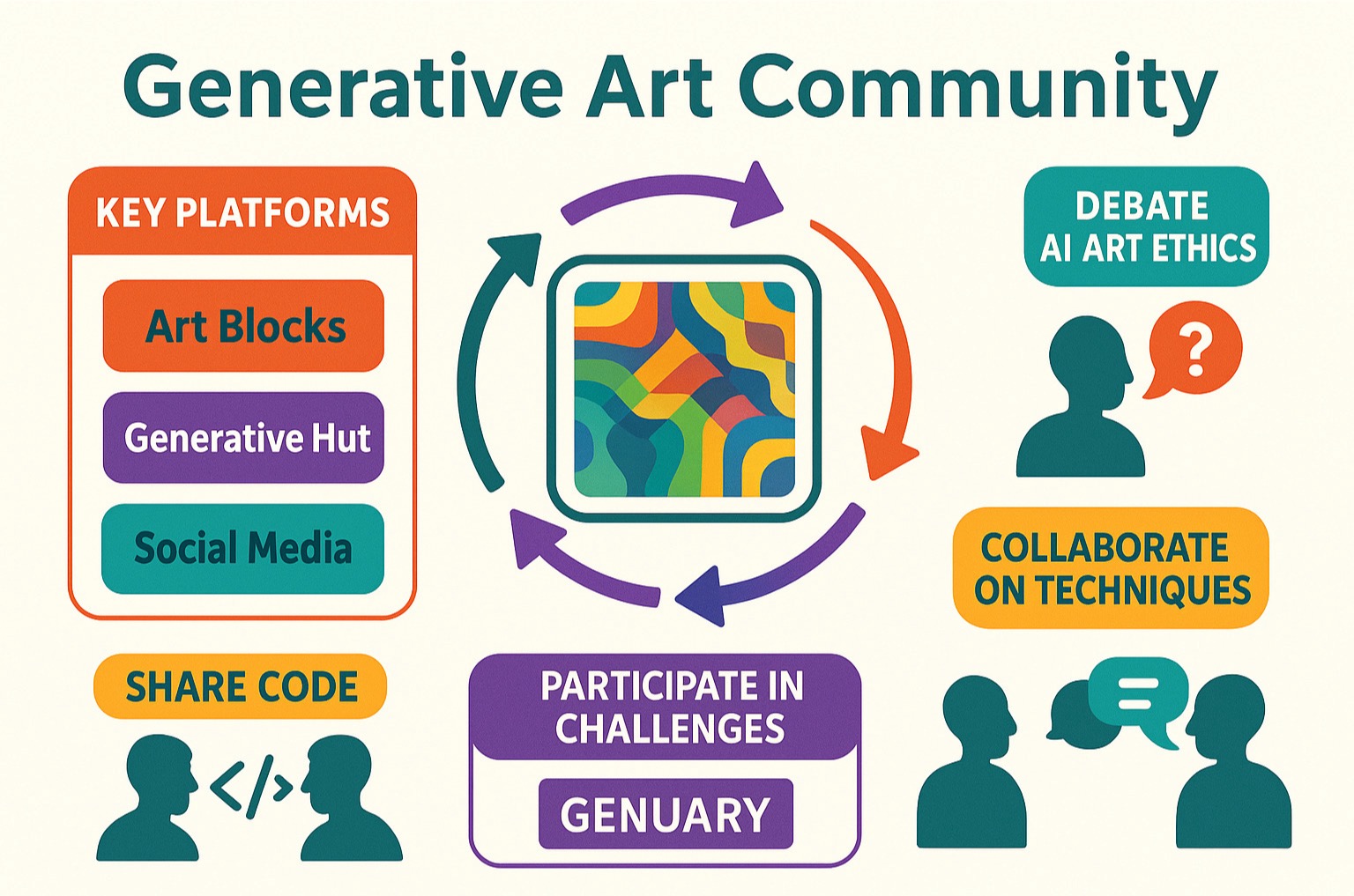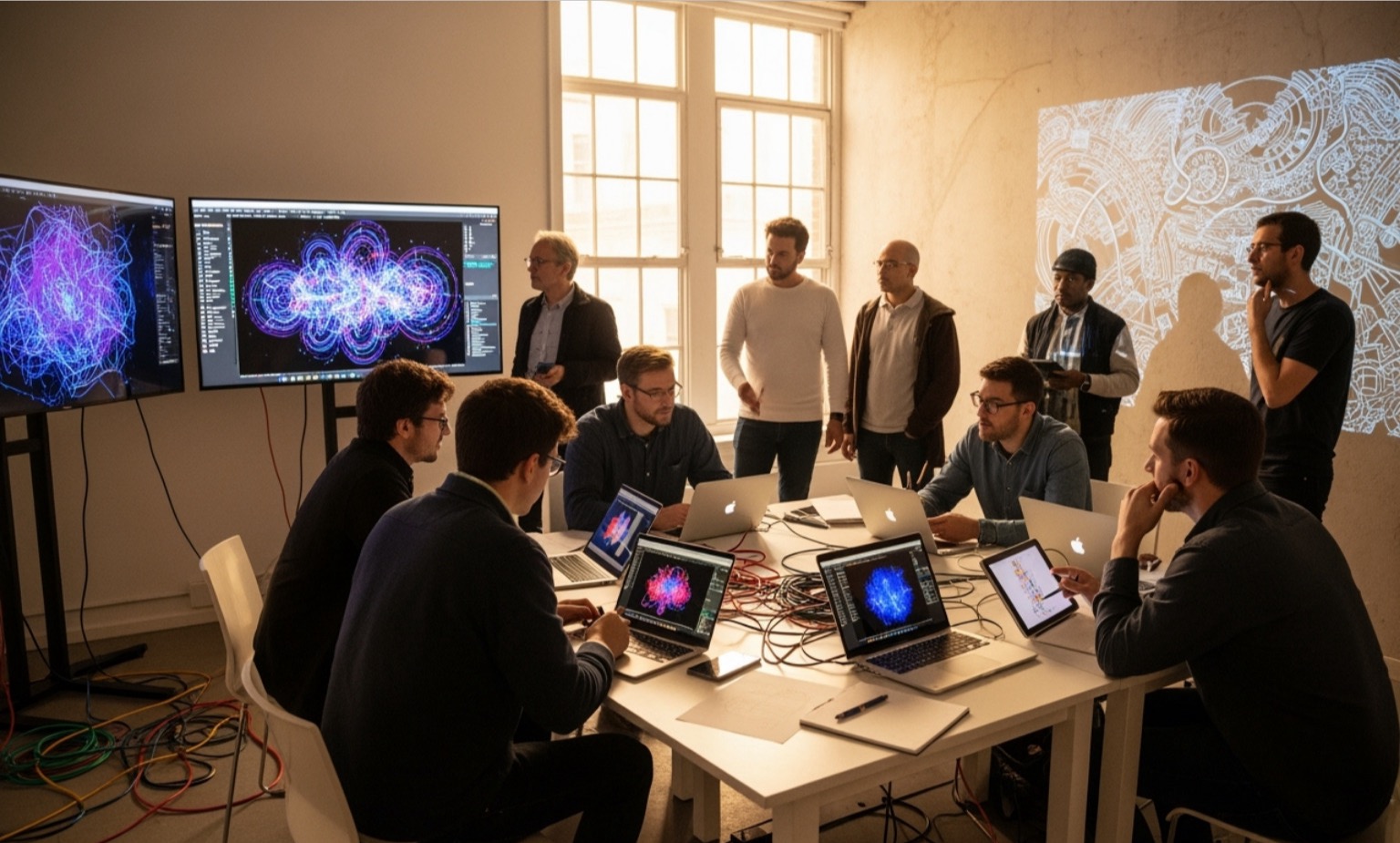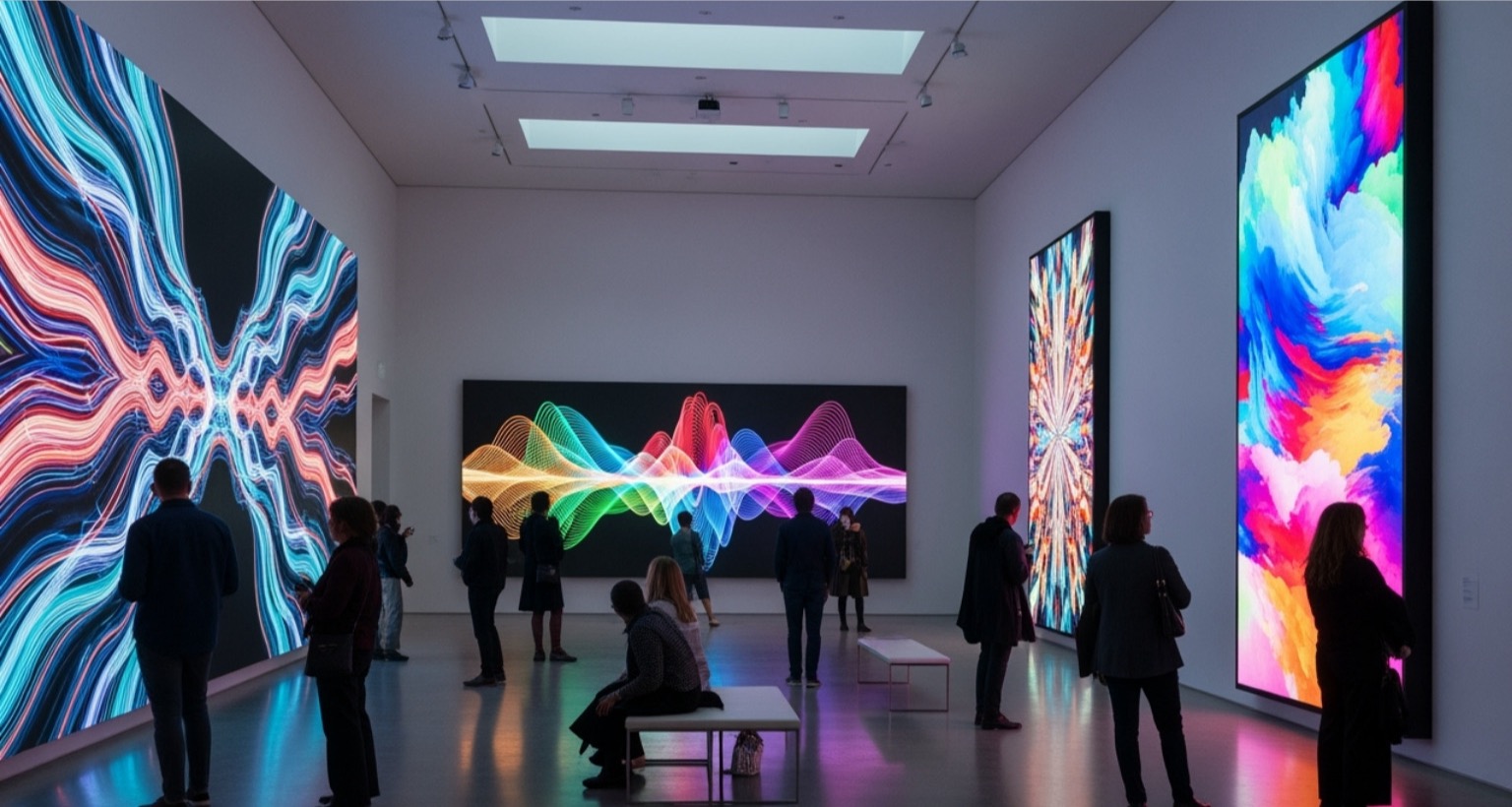Generative Art: Your Guide to Thriving Communities
Why the Generative Art Community Matters.

The generative art community is a global network of creators, coders, and collectors who use algorithms and AI to make art. Here's what defines this vibrant ecosystem:
Key Community Platforms:
- Art Blocks - Premier blockchain platform for generative art
- Generative Hut - 70,000+ member global community
- Social platforms - Twitter, Instagram, Discord servers
- Events - GENUARY coding challenges, NFT.NYC showcases
How Artists Collaborate:
- Share code and techniques openly
- Participate in daily coding challenges
- Exchange prompts and methods
- Support each other's exhibitions
Pierre Paslier, founder of Generative Hut, captures the essence perfectly: "I'm obsessed with drawing robots, buying way too many pens, and never knowing how a drawing will end up looking." This spirit of experimentation and surprise drives the entire community.
The generative art world thrives on openness. Unlike traditional art circles, creators freely share code, techniques, and prompts. From the annual GENUARY event to platforms like Art Blocks where collectors co-create unique pieces, collaboration is everything.
But it's not without controversy. The rise of AI art has sparked heated debates about ethics, copyright, and what constitutes "real" creativity. Communities like "Are We Art Yet?" are working to establish ethical frameworks that respect traditional artists while embracing new technology.
Whether you're a seasoned coder or curious about AI-generated art, this community offers spaces to learn, create, and connect with others pushing the boundaries of what art can be.

The Digital Town Squares: Where the Generative Art Community Gathers
Just like artists of old gathered in Parisian salons, the modern generative art community has its own vibrant meeting places. These digital "town squares" span the globe, connecting creators through code and shared enthusiasm. These online hubs are at the heart of a massive shift in how art is created, shared, and discussed.
Key Platforms and Organizations
At the forefront of this digital revolution are several pivotal platforms and organizations that serve as pillars for the generative art ecosystem.
Art Blocks: Considered a premier destination for generative art, Art Blocks is a leading blockchain platform. Artists publish algorithmic systems, and collectors "activate" them to create one-of-a-kind artworks. This innovative model ensures digital ownership and provenance, fostering a dynamic relationship between creators and collectors. Its influence is significant, having activated countless unique pieces. You can explore their vision at Art Blocks.
Generative Hut: Founded by Pierre Paslier in 2019, Generative Hut has blossomed into a global community of over 70,000 members with a massive Instagram reach. This platform is a testament to personal passion turning into a thriving collective. It's a space for collaboration, showcasing, and education, where artists share their journeys with tools from Cinema4D to pen plotters like Axidraw V3/A3 and Line-Us. Generative Hut exemplifies how a personal obsession can grow into a supportive network.
genart.social & ARTXCODE: While specific details on genart.social weren't provided in our immediate sources, it's representative of the growing number of dedicated social platforms emerging for generative artists. ARTXCODE, championing "the culture of code since 2016," signifies the importance of organizations dedicated to fostering the underlying technical craft of generative art. These platforms provide spaces for artists to connect, share work, and discuss the intricacies of creative coding.
Generative Art Foundation: The Generative Art Foundation focuses on the long-term sustainability and recognition of generative art. Established in 2021 by Erick Calderon and Jeff Davis, its mission is to support the community through grants, educational outreach, preservation efforts, and strategic partnerships with cultural institutions. By championing diversity and inclusivity, the foundation works to solidify generative art's place in history, and we believe its work is vital.
How to Join the Online Generative Art Community
The beauty of the online generative art community is its accessibility. You don't need a gallery invitation to jump in.
Social Media Hubs: Platforms like Twitter and Instagram are buzzing with generative artists sharing daily progress, behind-the-scenes code, and finished pieces. To find them, follow prominent figures and explore hashtags like #generativeart, #creativecoding, #genart, and #genuary. These hashtags act as digital breadcrumbs leading to a treasure trove of art and artists.
Specialized Forums and Feeds: Beyond mainstream social media, niche forums and blogs offer deeper dives. These are places for sharing original AI art, discussing techniques, and exchanging resources like code notebooks for models like MidJourney and Disco Diffusion. These platforms allow for more in-depth technical discussions and focused collaboration.
Discord Servers: Discord has become a go-to for real-time interaction. Many artists and collectives host their own servers, offering channels for sharing work, asking questions, and finding collaborators. The 'Are We Art Yet?' collective, focused on ethical AI art, invites interested individuals to Join the AWAY Discord server to engage in discussions. We've found these servers to be incredibly welcoming.
Joining is as simple as following, engaging, and sharing. We encourage you to dive in, comment on art that inspires you, and share your own creative journey.
The Collaborative Code: How Artists Create and Share Together
What makes the generative art community truly special isn't just the stunning visuals—it's the generous spirit of sharing. Unlike traditional art scenes where techniques are guarded secrets, generative artists accept an open-source ethos rooted in coding culture, where building on others' work is how innovation happens.
When an artist shares their algorithm on GitHub or posts their prompt on social media, they're contributing to a collective knowledge base that helps everyone create better art.

We've watched this community grow stronger through shared challenges and collaborative projects. The result? Faster learning, breakthrough innovations, and friendships that span continents.
GENUARY: A Month of Creative Coding
Every January, thousands of artists in the generative art community participate in GENUARY, a month-long event dedicated to building code that creates art.
For 31 days, participants receive a daily prompt—like "draw 10,000 of something"—and create generative pieces using any medium. The diversity is incredible, from Processing sketches to AI images and physical pen plots.
What we love most about GENUARY is its relaxed attitude. The organizers make it clear that it's fine to skip days, and "cheating is encouraged" (meaning you can adapt prompts however you want). As they humorously put it: "You can even use vim, it's not like I can stop you."
This low-pressure environment creates space for experimentation and learning. Artists share their daily creations using hashtags like #genuary and #creativecoding, creating an inspiring feed of collective creativity. These shared works often get collected in online galleries, turning individual practice into a massive community showcase.
The skill development during GENUARY is remarkable. We've seen beginners make incredible progress in just one month, while experienced artists push into new territories. It's proof that daily practice and community support can accelerate growth in ways that solo work can't match. You can check out GENUARY 2025 when the time comes!
Showcasing and Learning from Peers
Beyond structured events like GENUARY, everyday interactions fuel continuous learning. Artists don't just post finished pieces; they share their processes, struggles, and breakthroughs.
Social media showcases have become informal classrooms. On Instagram, Twitter, and Behance, artists regularly post code snippets alongside their visual results, turning their feeds into mini-tutorials.
Sharing prompts and techniques has become an art form, especially in AI-generated work. In dedicated online communities, artists openly share the specific prompts they used for a piece. This transforms prompt engineering from a solo skill into a collaborative craft where everyone benefits from shared findings.
Following prominent figures offers a masterclass in technique and philosophy. Artists like Aaron Penne, featured at NFT.NYC 2023, share insights into their process. Helena Sarin @DrBeef_ demonstrates innovative approaches to AI art, while Manolo Gamboa Naon bridges digital techniques with art history.
Robbie Barrat broke new ground with AI-generated portraits, Pierre Paslier built the Generative Hut community, and Erick Calderon & Jeff Davis revolutionized the space with Art Blocks. These artists don't just create—they teach, mentor, and build platforms that lift up the entire community.
From Pixels to Pedestals: Events, NFTs, and the Art Market
What started as coders experimenting with algorithms has transformed into a legitimate segment of the contemporary art market. The generative art community has witnessed its digital creations move from computer screens to gallery walls and from free downloads to million-dollar sales.
This change was driven by dedicated events, passionate advocates, and the technology of NFTs, which bridged the gap between digital creation and traditional art collecting.

The Role of Events and Showcases
Art events are the heartbeat of any creative community, and for generative artists, they are essential lifelines connecting their digital work to real-world recognition.
NFT.NYC has emerged as a vital stage for generative art. The 2023 event featured a Community Artist Showcase spotlighting creators like Aaron Penne and Aissa Santiso. These showcases introduce collectors to the artists behind the algorithms and help the public understand the skill involved in computational art.
Traditional art institutions are opening their doors too. The Generative Art Foundation supports museum exhibitions and works with cultural institutions to feature generative art. This integration validates the practice and introduces it to new audiences.
The connections formed at these events are magic. Artists spark collaborations, collectors find emerging talent, and the public sees how algorithms create beauty. These gatherings are invaluable for spotting trends and understanding the community's direction.
The Impact of NFTs on the Generative Art Community
Before NFTs, digital artists faced a fundamental problem: how do you sell something that can be infinitely copied? NFTs didn't just solve this; they revolutionized how generative art is created, owned, and valued.
Digital scarcity became real. NFTs provide unique, verifiable tokens on the blockchain that prove ownership of a specific digital artwork. A generative piece became a collectible asset with provable rarity and ownership history.
For artists, this opened new revenue streams. Platforms like Art Blocks pioneered a model where artists publish algorithms and collectors "activate" them to generate unique works. Every time someone mints a new piece, the artist gets paid, creating a sustainable model.
Collector engagement has also been transformative. Buying generative art via NFTs is participating in the creative process. The blockchain provides complete transparency about a work's provenance, something traditional art has struggled with for centuries.
CryptoPunks are a perfect example. These algorithmically generated characters became cultural icons, proving that computational art could achieve massive cultural impact and serious financial value. They helped establish the CryptoArt movement and showed that digital art could be as valuable as anything in a museum.
The Generative Art Fund itself was established using proceeds from Art Blocks' projects sold at Sotheby's—a clear sign that the traditional art world was taking notice. This economic shift has enabled countless artists to pursue computational art full-time.
The Ghost in the Machine: Navigating AI Art and Ethics
The generative art community is at a fascinating crossroads. Powerful and accessible AI tools are stirring up passionate debates about the meaning of art. The "ghost in the machine" represents the very real questions artists now face. These conversations can get heated, but they show a community wrestling with profound changes while trying to stay true to its collaborative roots.
The Great Debate: Is AI Art "Real" Art?
Walk into any Discord server or scroll through Twitter, and you'll likely find this debate. Many artists in the generative art community see AI as another tool in their creative toolkit. Prompt engineering—the art of crafting text instructions for AI models—is a recognized skill that takes practice, creativity, and an understanding of how these systems work.
As one insightful thread explains, AI ISN'T AN AUTOMATIC COLLAGING MACHINE. There's real skill involved in coaxing beautiful work from these systems.
But things get complicated. The controversy around the AI artwork that sold for $450,000 at Christie's shows how raw these feelings can be, as many in the community felt other artists deserved recognition instead.
The style replication issue hits particularly close to home. When AI models train on millions of images—often without permission—it raises tough questions. Is this just technological evolution, like photography challenging painting, or something more troubling?
Building an Ethical Framework
Instead of just arguing, parts of the community are actively seeking solutions. It's messy work, but it's essential.
The collective Are We Art Yet? is leading some of these efforts, describing themselves as a community exploring AI art ethically without undermining traditional artists. Their practical approach suggests AI art can coexist with traditional forms.
Their community code of ethics includes concrete steps, such as encouraging artists to honor requests from traditional artists who don't want their styles replicated. They suggest avoiding the styles of artists who've publicly spoken out against AI art and instead push for synthesizing new styles from unexpected combinations.
The public domain inspiration approach is also gaining traction. There are centuries of incredible work to explore without stepping on anyone's toes.
Transparency is another key topic. Should AI artists always disclose their methods? What about the environmental impact of energy-hungry data centers? These questions don't have easy answers, but the community is asking them.
Artists are also struggling with corporate influence and how it might change the collaborative, open-source spirit that makes generative art special. These conversations are shaping how the generative art community evolves, balancing new technology with core values.
Frequently Asked Questions about the Generative Art Community
If you're curious about diving into this fascinating world, you're not alone. We get these questions all the time.
Do I need to be a programmer to join the generative art community?
Not really. While generative art is rooted in code, the barriers to entry are lower than ever. Many AI tools let you create art simply by writing a text prompt—no code required. However, understanding basic coding concepts opens up far more creative potential, and tools like Grasshopper can expand your capabilities. The generative art community welcomes everyone, from beginners using prompts to advanced programmers building custom frameworks. The key is to start where you are and grow from there.
What's the difference between traditional generative art and AI art?
Traditional generative art, practiced for over 50 years by artists like Sol Lewitt, involves writing specific algorithms or rules to create art. It's like giving a computer a precise blueprint.
AI art is a newer form of generative art. Instead of writing explicit rules, you guide AI models that have learned from vast datasets of images. You act more like a director, providing a vision that the AI interprets.
While the interaction is different, both use algorithms to create art. Many artists now blend both approaches, using code and AI tools to create innovative hybrid works.
How can I start creating my own generative art?
Getting started is easier than you think, and the generative art community is incredibly welcoming.
- Start with accessible tools: For coding, try Processing or p5.js. For AI, platforms like MidJourney or Stable Diffusion are great starting points.
- Learn by doing: Don't wait for mastery. Follow a tutorial, experiment with prompts, and see what happens. Developing your prompt engineering skills is valuable.
- Join the community: This is crucial. Join Discord servers, follow artists on social media, and participate in events like GENUARY. The knowledge sharing is immense.
- Experiment and share: There's no "wrong" way to create. Share your work, ask questions, and contribute. The community thrives on this open exchange.
Conclusion: Find Your Tribe and Start Creating
The generative art community isn't just a collection of artists and coders – it's a living ecosystem where creativity meets technology in exciting ways. We've explored how this vibrant world thrives on collaboration, open sharing, and a passion for pushing what art can become.
From the digital hubs of Art Blocks and Generative Hut to the creative marathon of GENUARY, this community proves algorithms can create magic. The journey from pixels to pedestals, accelerated by NFTs, has opened doors for artists, allowing them to connect with collectors and make a living from their work.
But this isn't a utopia. The rise of AI art has sparked important conversations about creativity and ethics. What we love is how this community tackles these tough questions head-on. Groups like "Are We Art Yet?" are building ethical frameworks, while platforms ensure artists get credited and compensated.
Whether you're fascinated by creative coding, mesmerized by AI-generated visuals, or drawn to a community that celebrates experimentation, there's a place for you here. You don't need to be a programming wizard to start – curiosity and a willingness to learn will take you far.
The generative art community shows us that the future of art isn't about humans versus machines – it's about humans and machines creating something neither could achieve alone.
At Potions, we see this collaborative spirit every day. We believe prompt engineering shouldn't be a solo skill but a shared craft. Our platform helps you find those perfect prompts, remix them for your vision, and contribute back to a growing library of creative knowledge.
The algorithms are ready. The community is welcoming. All that's left is for you to dive in, start experimenting, and help shape what art becomes next. Explore collaborative prompting and begin your own generative art journey today.